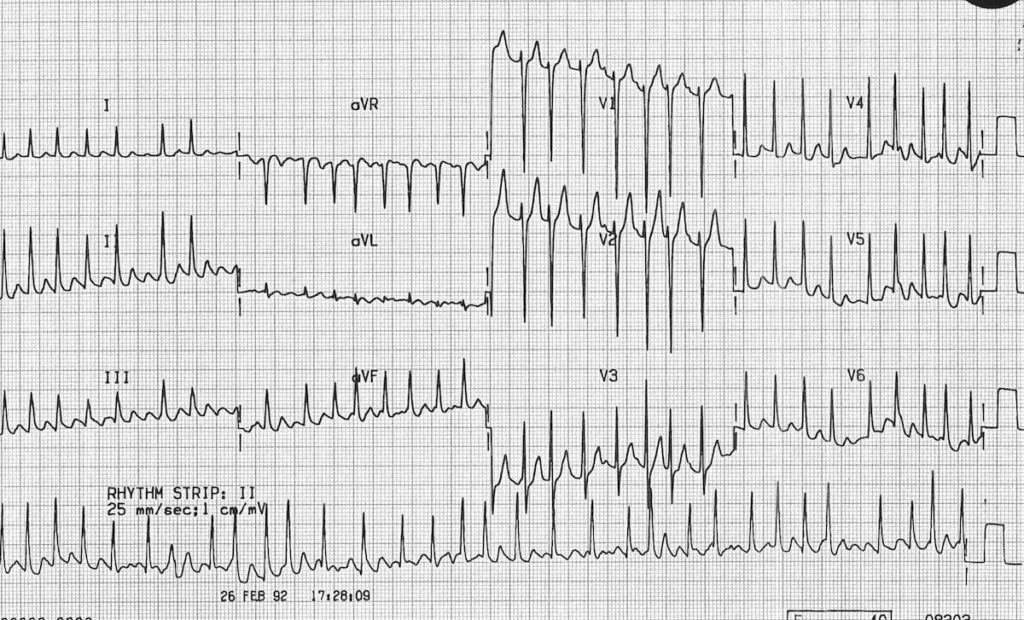Hyperthyroidism
ECG Abnormalities in Hyperthyroidism
The most common ECG changes seen with thyrotoxicosis are:
- Sinus tachycardia
- Atrial fibrillation with rapid ventricular response
- High left-ventricular voltage — i.e “voltage criteria” for LVH without evidence of LV strain
Other ECG abnormalities include:
- Supraventricular arrhythmias (premature atrial beats, paroxysmal supraventricular tachycardia, multifocal atrial tachycardia, atrial flutter)
- Non-specific ST and T wave changes
- Ventricular extrasystoles
Around 50% of patients with thyrotoxicosis will have a resting heart rate > 100 bpm. Atrial fibrillation is seen in up to 20% of patients. Severe thyrotoxicosis (thyroid storm) may present with atrial tachycardias at rates > 200 bpm.
Mechanism
- The ECG changes in thyrotoxicosis are principally related to increased activity of the sympathetic nervous system and the stimulatory effects of thyroid hormone on the myocardium.
- Atrial tissue is very sensitive to the effects of thyroid hormone, hence the preponderance of atrial tachydysrhythmias.
Useful Tips
- Patients with unexplained sinus tachycardia or atrial fibrillation should have their TSH and T4 checked to look for evidence of thyrotoxicosis.
- Thyrotoxic atrial tachydysrhythmias are treated with intravenous beta-blockers (e.g. titrated IV boluses of propranolol or an esmolol infusion).
ECG Examples
Example 1

Example 2

Related Topics
References
- Slovis C, Jenkins R. ABC of clinical electrocardiography: Conditions not primarily affecting the heart. BMJ. 2002 Jun 1;324(7349):1320-3
Advanced Reading
Online
- Wiesbauer F, Kühn P. ECG Mastery: Yellow Belt online course. Understand ECG basics. Medmastery
- Wiesbauer F, Kühn P. ECG Mastery: Blue Belt online course: Become an ECG expert. Medmastery
- Kühn P, Houghton A. ECG Mastery: Black Belt Workshop. Advanced ECG interpretation. Medmastery
- Rawshani A. Clinical ECG Interpretation ECG Waves
- Smith SW. Dr Smith’s ECG blog.
- Wiesbauer F. Little Black Book of ECG Secrets. Medmastery PDF
Textbooks
- Zimmerman FH. ECG Core Curriculum. 2023
- Mattu A, Berberian J, Brady WJ. Emergency ECGs: Case-Based Review and Interpretations, 2022
- Straus DG, Schocken DD. Marriott’s Practical Electrocardiography 13e, 2021
- Brady WJ, Lipinski MJ et al. Electrocardiogram in Clinical Medicine. 1e, 2020
- Mattu A, Tabas JA, Brady WJ. Electrocardiography in Emergency, Acute, and Critical Care. 2e, 2019
- Hampton J, Adlam D. The ECG Made Practical 7e, 2019
- Kühn P, Lang C, Wiesbauer F. ECG Mastery: The Simplest Way to Learn the ECG. 2015
- Grauer K. ECG Pocket Brain (Expanded) 6e, 2014
- Surawicz B, Knilans T. Chou’s Electrocardiography in Clinical Practice: Adult and Pediatric 6e, 2008
- Chan TC. ECG in Emergency Medicine and Acute Care 1e, 2004
LITFL Further Reading
- ECG Library Basics – Waves, Intervals, Segments and Clinical Interpretation
- ECG A to Z by diagnosis – ECG interpretation in clinical context
- ECG Exigency and Cardiovascular Curveball – ECG Clinical Cases
- 100 ECG Quiz – Self-assessment tool for examination practice
- ECG Reference SITES and BOOKS – the best of the rest
ECG LIBRARY
Emergency Physician in Prehospital and Retrieval Medicine in Sydney, Australia. He has a passion for ECG interpretation and medical education | ECG Library |
MBBS DDU (Emergency) CCPU. Adult/Paediatric Emergency Medicine Advanced Trainee in Melbourne, Australia. Special interests in diagnostic and procedural ultrasound, medical education, and ECG interpretation. Co-creator of the LITFL ECG Library. Twitter: @rob_buttner

